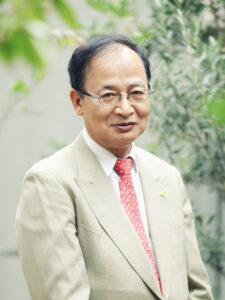What is FARET Tachikawa Art?
FARET Tachikawa, it is a town of 5.9 hectares including 11 buildings such as hotel, department store, cinema complex, library and office buildings, that was born on October 13, 1994 at the site of a former U.S. military base near the north exit of Tachikawa Station. The name of “FARET” is derived from the Italian word “fare” meaning “create”, added the letter “T” for Tachikawa to it. It received the City Planning Institute of Japan’s Planning and Design Award in 1994, and has been highly praised from the viewpoint of urban planning. Now many people are visiting both from home and abroad to “FARET Tachikawa”, and it is one of leading examples of art-based city planning.
The art director of FARET Tachikawa, Fram Kitagawa, envisioned this area as a forest, and installed works of art -like spirits living in it – based on following 3 concepts ; “A Town Reflecting the World”, “Function into Fiction (Art)!” and “A Town of Wonder and Discovery”. 109 works by 92 artists from 36 countries “FARET Tachikawa Art”, have practical city functions, such as bollards, benches, streetlights, ventilation ports, and shows the contemporary world of the end of the 20th century.
“FARET Club”, which is a citizen volunteer group established in 1997, offer guided tour, and organize art cleaning program and workshop” by the artists of “Faret Tachikawa Art”. They have guided “FARET Tachikawa Art” to more than 20,000 visitors since the group was established.
“FARET Tachikawa Art” is presented in art textbooks as a major example of public art. And since 2008, the appreciation of “FARET Tachikawa Art” has been included in the curriculum for elementary schools in Tachikawa city, serving as an “alive” instructional material.

30 Years of FARET Tachikawa
FARET Tachikawa Art Director, Furamu Kitagawa

photo by Mao Yamamoto
Thirty years have passed since 109 pieces of work by 92 artists from 36 countries and regions were installed on roads, walls, car stops, benches, water taps, tree circles, exhaust vents, and other urban art works in a cluster of buildings covering an area of approximately 6 hectares. Art has been loved by people as a fairy of fine art for 30 years. This public art is recognized as a model for urban development through art around the world, and has been an opportunity to revitalize Tachikawa City and the Tama area, but this was the result of the long-term activities of the Faret Club, the management association of building owners, and Tachikawa City. I am grateful. Even now, I hear many people from various places talk about their memories of Faret in their childhood and youth. I hope that this city, which reflects the world, turns urban functions into art, and is a fun place to travel, will continue to be loved even as times change.
*Mr. Fram Kitagawa was selected as Person of Cultural Merits (a person who have made significant contribution to culture) in 2018.